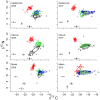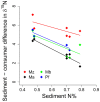Do deposit-feeders compete? Isotopic niche analysis of an invasion in a species-poor system
- PMID: 25988260
- PMCID: PMC4437029
- DOI: 10.1038/srep09715
Do deposit-feeders compete? Isotopic niche analysis of an invasion in a species-poor system
Abstract
Successful establishment of invasive species is often related to the existence of vacant niches. Competition occurs when invaders use the same limiting resources as members of the recipient community, which will be reflected in some overlap of their trophic niches. The concept of isotopic niche has been used to study trophic niche partitioning among species. Here, we present a two-year field study comparing isotopic niches of the deposit-feeding community in a naturally species-poor system. The isotopic niche analyses showed no overlap between a recent polychaete invader and any of the native species suggesting that it has occupied a vacant niche. Its narrow isotopic niche suggests specialized feeding, however, the high δ(15)N values compared to natives are most likely due to isotope fractionation effects related to nitrogen recycling and a mismatch between biological stoichiometry of the polychaete and the sediment nitrogen content. Notably, highly overlapping isotopic niches were inferred for the native species, which is surprising in a food-limited system. Therefore, our results demonstrate that invaders may broaden the community trophic diversity and enhance resource utilization, but also raise questions about the congruence between trophic and isotopic niche concepts and call for careful examination of assumptions underlying isotopic niche interpretation.
Figures





References
-
- Volterra V. Variations and fluctuations of the number of individuals in marine intertidal species living together. J. Conseil. 3, 3–51 (1928).
-
- Abrams P. A. The theory of limiting similarity. Annu. Rev. Ecol. Evol. Syst. 14, 359–376 (1983).
-
- Shea K. & Chesson P. Community ecology theory as a framework for biological invasions. Trends Ecol. Evol. 17, 170–176 (2002).
-
- Elton C. The ecology of invasions by animals and plants. Methuen, London, UK. (1958)
-
- Byers J. E. Competition between two estuarine snails: implications for invasions of exotic species. Ecology 81, 1225–1239 (2000).
Publication types
MeSH terms
LinkOut - more resources
Full Text Sources
Other Literature Sources
Miscellaneous

